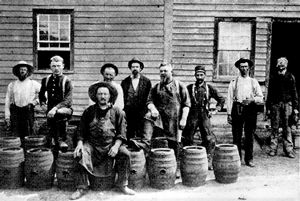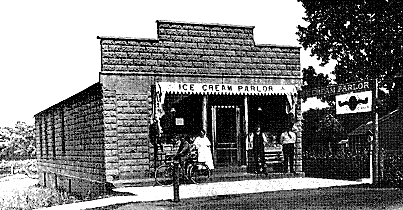History of the Village:
Wheeling Through The Years
The soft cover book Wheeling Through the Years
an oral history of Wheeling, an Illinois village contains
over 250 8x11 pages, and is available for purchase through the
Historical Society for $25.00 directly, or by mail with a $5.00
shipping and handling charge.
This book contains chapters on growing up in Old
Wheeling, school days, girl scouts, homesteading, Yankee farmers,
German farmers, Wheeling Train Station, Crane farms, Denoyer farm,
Milwaukee Avenue, Early planes and airports, prohibition, World War
II, Hispanics, organizations, churches, and much more. Illustrated
with photographs from the 1700's through the 1980's. Some
samples are included below.
If you are at all interested in Wheeling's past, we would like very much for you to join us in the preservation of our history and artifacts. If you would like to become an active member of the Wheeling Historical Society, please fill out the online application and mail it to us. and mail it to us.
TWO TRADES that failed to survive the transition from the horse-and-buggy days to the automobile age were that of wagon builder and harness maker. Louis Fischer bought the Reese Wagon Shop in 1868. Reinhold Schneider bought his saddlery from Chris Welflin around the turn of the century. |
 |
 |
WHEELING'S FIRST BANK was in this former ice cream store attached to Fassbender's Hardware Store on the southeast corner of Milwaukee Avenue and Dundee Road. It was Wheeling State Bank, founded in 1921 by a group of local businessmen. |
| NEW BANK BUILDING on the southwest corner was opened in 1927 and contained a drug store, real estate office and a beauty shop. The telephone exchange was on the second floor. |
 |
 |
GIANT MIXER gobbled up cement, sand and gravel through a huge ladle which was raised high to dump it in. The mixture poured out the back, to be leveled into a smooth surface. |
| FLAGS WERE DISPLAYED to celebrate the completion of Milwaukee Avenue paving, and a street dance was held before the avenue was opened to traffic. The paving had progressed from the south to Dundee Road by 1917. It was later, in 1922, that paving to the north of Dundee was completed. Better roads and the rising popularity of the automobile contributed to the success of Wheeling's stores and restaurant row. |
 |
 |
BEFORE PAVING, Milwaukee Avenue was a gravel road that served well enough in dry summer months if you didn't mind the bumps and dust. In the spring, though, it became soft and rutted and it took an eight-horse team to pull the grader that smoothed it out until the next rain softened it again. |
|
| MILWAUKEE AVENUE became a major route to the Chain of Lakes and the lake country farther north, and the Kraus Bait Shop north of Dundee Road was an important stop for fishermen on the way. |
 |
 |
ORIGINAL PLAT of Wheeling shows the village extending west from the river past tracks of the Wisconsin Central Railway. |
| BRICKYARDS provided employment for many Wheeling men. This was Illinois Brick Co. on Lake-Cook Road at the Milwaukee Railway crossing. The Bach Brickyard in Northbrook was another. |
 |
 |
OLD PRESBYTERIAN CHURCH was built in 1865, lost its steeple in a lightning storm. Last service was held in 1962. The building was moved to its present site in Chamber Park in 1968. |
| THE ICE HOUSE was important in early Wheeling. Restaurants and butcher shops had them, usually by the river. |
 |
 |
HUGE WOODEN FORMS shaped the concrete bridge that is still in place where Dundee Road crosses the Des Plaines River. Meanwhile, a low, temporary structure (right) had to serve. |
| CREAMERY was built in the thirties by Charles F. Balling. It is on the site of an earlier dairy operated by Henry Boehmer, President of Wheeling's first Board of Trustees. |
 |
 |
BICYCLE RACES often began or ended at Wheeling. This program for a 100-mile road race contained an ad for Behm's Union Hotel, which was a register station or check-point for the race. |
AFTERNOON SUN streamed into Crawford's Ice Cream Store next to Fassbender's Hardware on the southeast corner of Milwaukee Avenue and Dundee Road. Later it served as the first Wheeling Bank building and as a Royal Blue grocery store. |
 |
 |
REEB'S MILL ground feed for cattle and hogs, was opened in 1920. In the fall it also pressed apples for cider. Long in disrepair, the mill and adjacent house and barn were torn down in 1986 when the Main Bank of Wheeling bought the land.
|
CLYBOURN PARK was north of Wheeling and east of the river, and was reached by Soo Line excursions. It was an amusement park and a popular place for picnics and baseball games. In foreground with a pair of baseball bats is August Pieper.
|
 |
 |
WHEELING CORNET BAND played for many occasions as varied as Fourth of July celebrations and funerals. This photo is from Jake Ott's music book, with some notes written in hand. |
| THE PERIOLAT BREWERY, across Milwaukee Avenue from the Union Hotel, was established by Napoleon Periolat in 1850. He was succeeded by his sons Robert and Henry, who continued to operate it until 1905 when it was bought by a Chicago firm. |
 |
 |
SPRAWLING BREWERY BUILDINGS are reflected in this view from across the river. They were demolished after the business shut down in 1910. This picture is from the album of George Periolat, grandson of the founder and amateur photographer.
|
| FIRE LEVELED the original Union Hotel on December 26, 1925, when the temperature was 18 below zero. It was rebuilt as a brick structure which still stands as Billy & Co. in 1986. |
 |
|
























